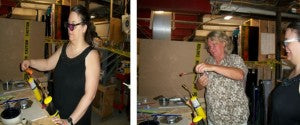WHICH SIDE IS THE COATED SIDE OF DICHROIC
Some Info from The Frog Blog
Dichroic glass is so beautiful and there are so many uses, it is just delightful. However, there are a few problems that knowledge can help deal with.
One is that it is impossible to tell 96 from 90 COE if you get them mixed up. The answer to this one is—DON’T mix them up. Keep them labeled. If you keep scrap, keep it in a well-marked box.
It is often important to know which side the dichroic coated side is to get the look you are going for. If it has a dark base, no problem—you can see it. However, on a transparent base, it can look the same on both sides! Reasons you may want to know this?
Cutting. Always cut on the non-coated side of the glass. It will help prevent chipping, especially on textured glass. It also saves your cutter.
Coated Side Down. When using the coated side down or capped with clear glass, the dichroic glass will have a smooth glossy surface and sparkle like glitter. It will also change colors between the transmitted color and a completely different reflective color, depending of the angle of view.
Coated Side Up. If you use the dichroic glass with the coated side up or uncapped, the dichroic surface will have a highly metallic sheen. The piece may additional be rough and textured depending on the type of dichroic glass you are using.
 This is what to do. Place the glass over a dark background. Look at the glass at an angle so that you are seeing the reflection of the dichroic. Touch the surface with a paperclip (don’t scratch it). The paperclip will reflect.
To know your answer. Does the reflection meet the paper clip, or there a gap between the clip and its reflection?
This is what to do. Place the glass over a dark background. Look at the glass at an angle so that you are seeing the reflection of the dichroic. Touch the surface with a paperclip (don’t scratch it). The paperclip will reflect.
To know your answer. Does the reflection meet the paper clip, or there a gap between the clip and its reflection?
 This is what to do. Place the glass over a dark background. Look at the glass at an angle so that you are seeing the reflection of the dichroic. Touch the surface with a paperclip (don’t scratch it). The paperclip will reflect.
To know your answer. Does the reflection meet the paper clip, or there a gap between the clip and its reflection?
This is what to do. Place the glass over a dark background. Look at the glass at an angle so that you are seeing the reflection of the dichroic. Touch the surface with a paperclip (don’t scratch it). The paperclip will reflect.
To know your answer. Does the reflection meet the paper clip, or there a gap between the clip and its reflection?
















